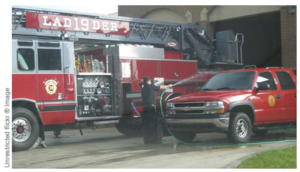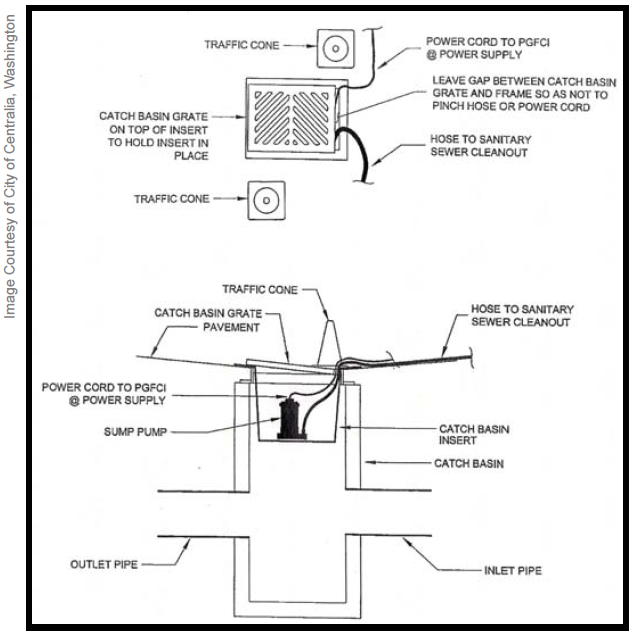
Difference between revisions of "MS4 fact sheet - Vehicle Washing"
| Line 38: | Line 38: | ||
Car | Car | ||
| − | [[File:Car wash catch basin insert for diversion to sanitary sewer.PNG |right|thumb| | + | [[File:Car wash catch basin insert for diversion to sanitary sewer.PNG |right|thumb|900 px|alt=This image shows a car wash catch basin insert for diversion to sanitary sewer|<font size=3>Car wash catch basin insert for diversion to sanitary sewer</font size>]] |
Revision as of 16:43, 14 February 2017
Contents
Vehicle Washing
Vehicle fleet wash water management
MS4 vehicle washing involves the removal of dust and dirt from the exterior of trucks, boats and other vehicles, as well as the cleaning of cargo areas and engines and other mechanical parts. Washing of vehicles and equipment generates oil, grease, sediment and metals in the wash water as well as degreasing solvents, cleaning solutions and detergents used in the cleaning operations.
The impacts of these constituents discharging to downstream water bodies include increased biochemical oxygen demand (BOD), increased temperature and acidity, and reduced oxygen levels. These environmental effects cause potentially fatal physiological disorders and reduced immune status in aquatic fish and other organisms.
The EPA considers wash water to be a non-stormwater discharge (i.e. illicit discharge); therefore, wash water from a facility must be directed to a sanitary sewer or treated on-site prior to discharge. MS4s often own and maintain their own fleet of vehicles that may include cars, tractors, trucks, parks equipment, and other types of vehicles. This fact sheet provides guidance on techniques to reduce water pollution from the washing of MS4 vehicle fleets applicable to MS4 SWPPPs.
Benefits / Pollution Reduction
Appropriate vehicle wash water treatment and disposal helps to maintain the clarity, temperature and oxygen levels of downstream water bodies by keeping associated pollutants out of storm drains.
Program Development & Implementation
Programs designed to manage vehicle wash water include a combination of the elements identified below. The program elements implemented are dependent on the MS4’s access and authority to discharge to sanitary sewer, available resources, and size of staff and vehicle fleet.
Contracting Vehicle Washing Services
Properly maintained commercial washing and steam cleaning businesses are usually better equipped to handle wash waters and are permitted to discharge wash water to the sanitary sewer system. Negotiate with commercial car washes and steam cleaning businesses to handle fleet vehicle washing whenever possible. This option eliminates the cost of building the proper facility and the liability of operating it. However, this option may not be feasible for fleets of higher quantity or vehicles of larger size.
Wash Racks
MS4s with a large fleet of vehicles might consider building MS4-operated wash racks. Wash racks are designed to collect wash water and ultimately discharge to the sanitary sewer rather than the storm sewer. Wash racks consist of designated, paved wash areas that are bermed or sloped to contain and direct wash water to a collection point. Wash water is collected in a sump connected to the sanitary sewer, an on-site process treatment system, or an enclosed recycling system. Connections to the sanitary sewer need approval from the sewer authority and may require pretreatment.
On-site Treatment
Another suitable option is to contain and treat all wash water on the premises by using a detention pond or bermed area that will retain the wash water on site to evaporate and infiltrate. An individual NPDES/SDS permit is needed for such a treatment system. Separate containment is required for salt brine.
MS4-Operated Vehicle Washing Facility BMPs
Designated area Wash all vehicles in designated areas only. Wash vehicles inside or under cover wherever possible. When washing outdoors, provide an impervious concrete wash pad with a collection system. Alternatively, consider a pervious wash area where infiltration precludes runoff to storm drains. Depth to ground water table and local geology must be considered in this case; avoid this practice in areas with shallow ground water tables and karst topography.
Collect wash water Wash all vehicles in designated areas designed to collect and hold wash water before discharge to the sanitary sewer system (e.g. berming). Pretreatment may be required prior to discharge to the treatment plant. Contact your sewer authority early in the design process. In areas not served by a sanitary sewer, haul contents of the holding tank to a treatment plant. If the parking lot has a catch basin connected to a storm sewer, this can be used as a collection point. The storm sewer could be temporarily blocked or plugged so that a temporary pump or vacuum could collect the wash water which can then be disposed of in a sanitary sewer or holding tank. Car

